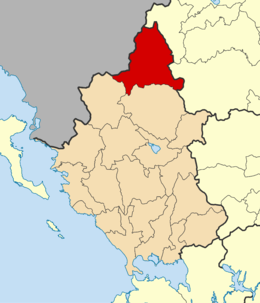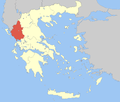Konitsa
| Konitsa Κόνιτσα | |
|---|---|
|
View of Konitsa. | |
 Konitsa | |
|
Location within the region  | |
| Coordinates: 40°3′N 20°45′E / 40.050°N 20.750°ECoordinates: 40°3′N 20°45′E / 40.050°N 20.750°E | |
| Country | Greece |
| Administrative region | Epirus |
| Regional unit | Ioannina |
| Area | |
| • Municipality | 949.9 km2 (366.8 sq mi) |
| • Municipal unit | 542.5 km2 (209.5 sq mi) |
| Elevation | 600 m (2,000 ft) |
| Population (2011)[1] | |
| • Municipality | 6,362 |
| • Municipality density | 6.7/km2 (17/sq mi) |
| • Municipal unit | 4,632 |
| • Municipal unit density | 8.5/km2 (22/sq mi) |
| Time zone | EET (UTC+2) |
| • Summer (DST) | EEST (UTC+3) |
| Postal code | 441 00 |
| Area code(s) | 26550 |
| Vehicle registration | ΙΝ |

Konitsa (Greek: Κόνιτσα; Aromanian: Conita) is a town in Epirus, Greece, near the Albanian border. It lies, amphitheatre-shaped, on a mountain slope of the Pindos mountain range, overlooking the valley where the river Aoos meets the river Voidomatis. The valley is used for farming. Konitsa is a regional centre for many small Pindos villages, and there are shops, schools and a hospital. It is a good starting point for tourists who want to explore the Pindos mountains, or who want to go rafting in the river Aoos or parapenting. Other places of interest nearby are:
- The Vikos–Aoös National Park, including the Vikos Gorge, the Aoos Gorge and the Tymfi mountains. It is where Vikos spring water is collected;
- Mount Smolikas (2637 m), Greece's second highest mountain;
- The sulfur baths of Kavasila;
- The two Dragonlakes (Tymfi's and Smolika's)
- Zagori, a group of small mountain villages;
- The nearest city is Ioannina
History
In antiquity, the area of Konitsa was part of the territory of the Molossians.
In 15th century Konitsa came under Ottoman rule and became part of the Sanjak of Ioannina.[2][3]
A Greek school was operating already from the end of the 18th century under Georgios Mostras, student of Balanos Vasilopoulos. Greek education was flourishing and in 1906 the kaza of Konitsa had 31 schools and 1,036 pupils.[4] The functioning of the school was interrupted during the turbulent times of Ali Pasha's rule, however soon after it reopened following the initiative of Kosmas Thesprotos, a student of Athanasios Psalidas.[4] During the 19th century until the early 20th century, the tekke of Konitsa, similarly to other Albanian Bektashi tekkes, was a covert center of culture, learning and tolerance, but also Albanian national activism against the Ottoman Empire.[5] On the other hand, the local Greek population displayed tolerance towards actions by the Albanians that didn't reveal chauvinist inclinations.[6]
During the Greek Civil War (1946–1949) the surrounding region became a major battleground, while in December 1947 communist guerrilla units unsuccessfully tried to capture the town.[7] Almost all buildings inhabited by Muslim Albanians in Konitsa were destroyed during World War II warfare.[8]
Municipality
The present municipality Konitsa was formed at the 2011 local government reform by the merger of the following 5 former municipalities, that became municipal units (constituent communities in brackets):[9]
- Konitsa (Aetopetra, Agia Paraskevi, Agia Varvara, Aidonochori, Amarantos, Armata, Elefthero, Exochi, Gannadio, Iliorrachi, Kallithea, Kavasila, Kleidonia, Konitsa, Mazi, Melissopetra, Molista, Molyvdoskepastos, Monastiri, Nikanoras, Pades, Palaioselli, Pigi, Pournia, Pyrgos)
- Aetomilitsa
- Distrato
- Fourka
- Mastorochoria (Asimochori, Vourmpiani, Gorgopotamos, Drosopigi, Kallithea, Kastania, Kefalochori, Kleidonia, Lagkada, Oxya, Plagia, Plikati, Pyrsogianni, Chionades)
Province
The province of Konitsa (Greek: Επαρχία Κόνιτσας) was one of the provinces of the Ioannina Prefecture. It had the same territory as the present municipality.[10] It was abolished in 2006.
Historical Demographics
| Year | Town | Municipal unit | Municipality |
|---|---|---|---|
| 1981 | 2,859 | - | - |
| 1991 | 2,858 | 6,572 | - |
| 2001 | 2,871 | 6,225 | - |
| 2011 | 2,942 | 4,632 | 6,362 |
Notable people
- Konstantinos Dovas (1898–1973), Prime minister of Greece and Army general.
- Saint John Vrachoritis (-1813), Greek Orthodox Saint
- Eleftherios Oikonomou, former Chief of the Greek Police.
- Faik Konica (March 15, 1875 – December 15, 1942), writer and ambassador of Albania in Washington, DC
- Mehmet Konica, twice Foreign Minister of Albania
- Giannis Lyberopoulos, professor and author.
- Konstantis Pistiolis, clarinet player and vocalist
References
- ↑ "Detailed census results 2011" (in Greek).
- ↑ H. Karpat, Kemal (1985). Ottoman population, 1830-1914: demographic and social characteristics. p. 146. Retrieved 22 September 2011.
- ↑ Motika, Raoul (1995). Türkische Wirtschafts- und Sozialgeschichte (1071-1920). p. 297. Retrieved 22 September 2011.
Sancaks Yanya (Kazas: Yanya, Aydonat (Paramythia), Filat (Philiates), Meçova (Metsovo), Leskovik (war kurzzeitig Sancak) und Koniçe (Konitsa)
- ↑ 4.0 4.1 M. V. Sakellariou. Epirus, 4000 years of Greek history and civilization. Ekdotikē Athēnōn, 1997. ISBN 978-960-213-371-2, p. 307: ""In the city of Konitsa in particular, a Greek school had been founded at the end of the eighteenth century at which the.. "
- ↑ Sellheim, R. (1992). Oriens. BRILL. p. 298. ISBN 978-90-04-09651-6. Retrieved 3 October 2010.
- ↑ M. V. Sakellariou.Epirus, 4000 years of Greek history and civilization. Ekdotike Athenon, 1997. ISBN 960-213-371-6. p 361: "The Greek population displayed toleration whenever the action taken.
- ↑ Charles R. Shrader. The withered vine: logistics and the communist insurgency in Greece, 1945-1949. Greenwood Publishing Group, 1999 ISBN 0-275-96544-9, ISBN 978-0-275-96544-0, p. 215
- ↑ Kiel, Machiel (1990). Ottoman architecture in Albania, 1385-1912. Research Centre for Islamic History, Art and Culture. p. 3. ISBN 978-92-9063-330-3. Retrieved 1 November 2010.
- ↑ Kallikratis law Greece Ministry of Interior (Greek)
- ↑ Detailed census results 1991 PDF (39 MB) (Greek) (French)
External links
 |
Çarshovë, Qendër Leskovik (Albania) | Mastorochoria | Fourka |  |
| Ano Pogoni | |
Samarina | ||
| ||||
| | ||||
| Kalpaki | Central Zagori, Papingo | Tymfi, Distrato |
| ||||||||||||||||||||||||||||||
| ||||||||||||||||||||||
| ||||||||||||||||||||||||||||||||||||||||||||||||||||||||||||||||||||||||||||||||||||||||||||||||||||||||||||||||||||||||||||||||||||||||||||||||||||||||||||||||||||||||||||||||||||||||||||||||

